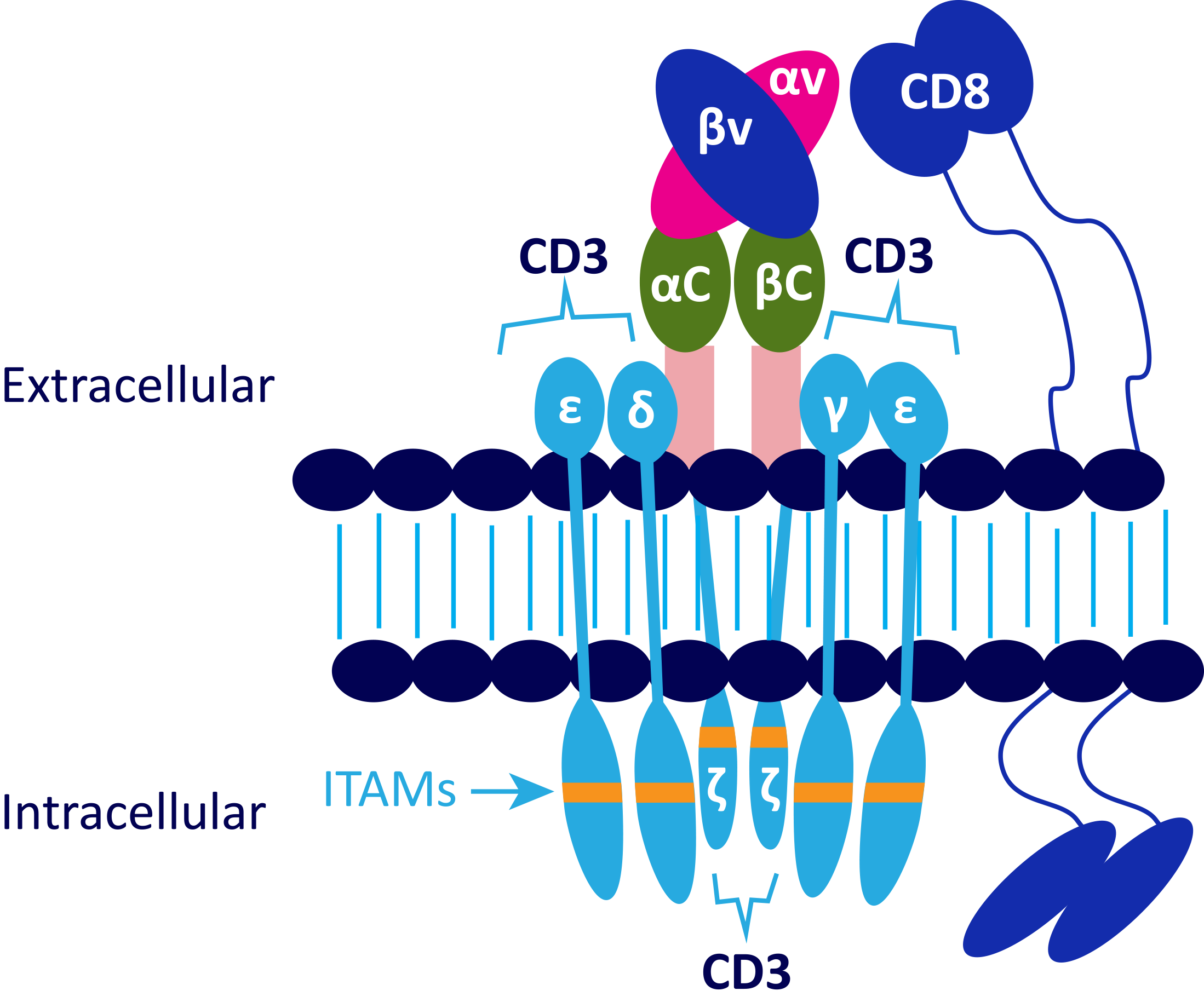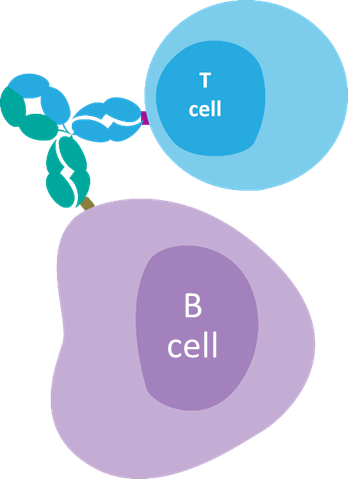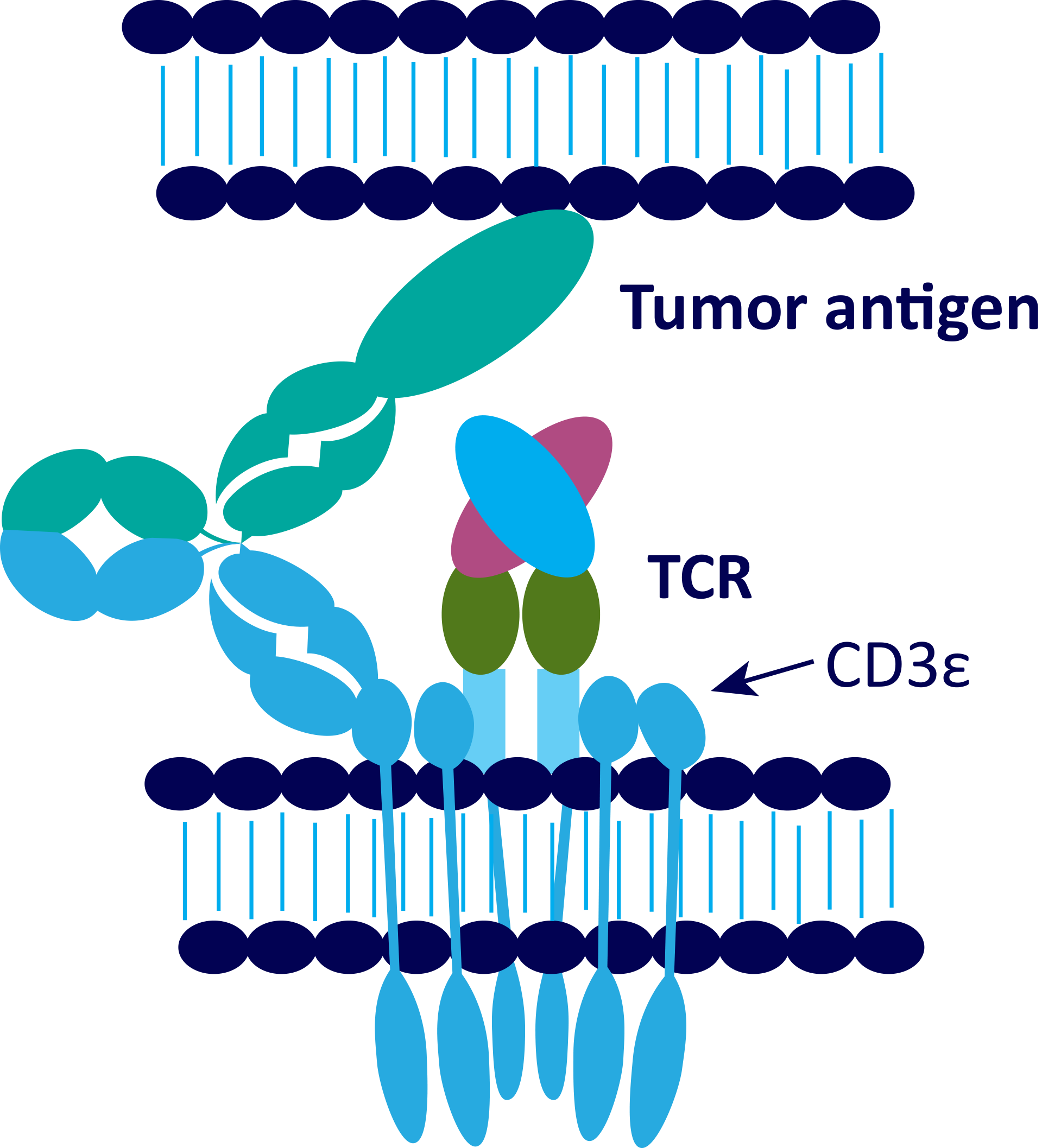CD3 x BCMA BISPECIFICS
OVERVIEW
T cell receptors (TCRs) are protein complexes formed by six different polypeptides. The CD3 (cluster of differentiation 3) complex is part of the T cell receptor (TCR) complex and is composed of two CD3ε, one CD3γ, one CD3δ, and two CD3ζ chains.1,2 The CD3 complex ensures signal transduction and plays an important role in T cell activation.1-3
BCMA (B cell maturation antigen) is only induced in late memory B cells committed to the plasma cell (PC) differentiation and is present on all PCs. BCMA supports the survival of long-lived PCs, the production of antibodies, and immunoglobulin class switching.4
A CD3 x BCMA bispecific antibody simultaneously binds to BCMA on plasma cells and to CD3 on T cells, inducing activation and cytotoxic activity of T cells and enabling lysis of BCMA-expressing plasma cells.1,4,5
Diagram of the TCR complex.
- CD3 bispecific antibodies (bsAb) induce the activation and cytotoxic activity of effector T cells, which enables lysis of target-expressing cells.1,3,5
- CD3 bsAb activate T cells by binding CD3 on T cells and a tumor-associated antigen (TAA), such as BCMA, on target cells. Consequently, available T cells can bind to target-expressing cells irrespective of the peptide/major histocompatibility complex (MHC) specificity of their TCR. 1,3
- Activation of the TCR-CD3 complexes leads to the formation of a cytolytic synapse between the T cell and the target cell, which results in the release of perforin and granzymes and subsequent target cell death by apoptosis.1
- T-cell redirection with bispecific antibodies in which one binding arm recognizes a tumor antigen and the other binding arm recognizes CD3 on T-cells.
- CD3 bsAbs in clinical trials either lack an Fc region or contain an engineered Fc domain to minimize interaction with Fc receptors.1,3
- The presence of an Fc domain increases the in vivo half-life through binding to the neonatal Fc receptor.3
- A key CD3 bsAb development consideration is the need for a format that either significantly limits or eliminates cyokine release syndrome (CRS) because CRS appears to be dose-limiting in most cases for this class of molecules1
IMPLICATIONS IN CANCER
Immunotherapy of cancer with CD3 bsAb is a fast developing field. Multiple TAAs are under evaluation for both hematological and solid tumor malignancies with many different CD3 bsAbs in clincial development.3,5 The idea of using the cytotoxic capacity of T cells through CD3 bsAb to kill tumor cells dates back to 1980’s.3,6
In multiple myeloma(MM), expression of BCMA is significantly increased on malignant versus normal PCs.4 Overexpression of BCMA promotes proliferation and survival of MM cells and is associated with an immunosuppressive bone marrow microenvironment; in addition, increased levels of soluble BCMA are associated with disease progression and poorer outcomes.4
CD3 x BCMA bispecific antibodies allow for dual BCMA-expressing cell targeting and CD3-expressing T cell activation.1,4,5
Related Research
- Strohl WR, Naso M. Bispecific T-Cell Redirection versus Chimeric Antigen Receptor (CAR)-T Cells as Approaches to Kill Cancer Cells. Antibodies (Basel). 2019;8(3):41.
- Alcover A, et al. Cell biology of t cell receptor expression and regulation. Annu Rev Immunol. 2018;36:85-107.
- Benonisson H, et al. CD3-bispecific antibody therapy turns solid tumors into inflammatory sites but does not install protective memory. Mol Cancer Ther. 2019;18(2):312-322.
- Cho SF, et al. Targeting B cell maturation antigen (BCMA) in multiple myeloma: potential uses of BCMA-based immunotherapy. Front Immunol. 2018;9:1821.
- Labrijn AF, Janmaat ML, Reichert JM, Parren PWHI. Bispecific antibodies: a mechanistic review of the pipeline. Nat Rev Drug Discov. 2019;18(8):585-608.
- Staerz UD, Kanagawa O, Bevan MJ. Hybrid antibodies can target sites for attack by T cells. Nature. 1985;314(6012):628-31.





